|
|
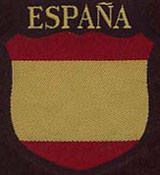 |
Division Azul
The Spanish Blue Division
By William Sariego
History
General Franco owed his position as dictator to Benito Mussolini and Adolph Hitler due to their support for the Nationalists during the Spanish Civil War (1936-1939). During that same conflict, the Union of Soviet Socialist Republics had supported his Republican enemies. |
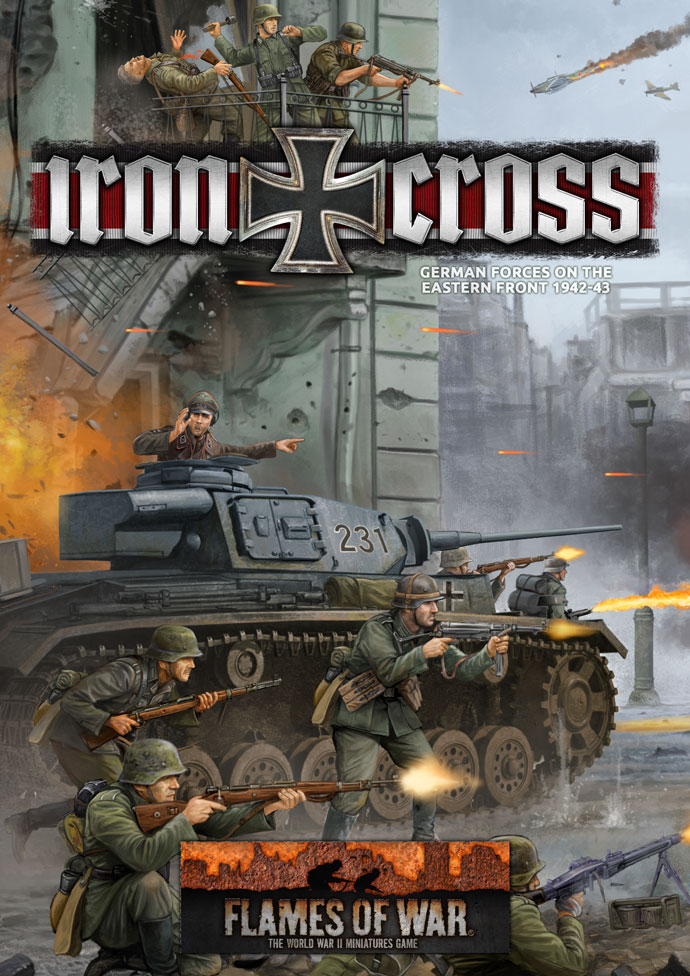 |
|
Hitler had previously attempted to entice Spain into the war after the fall of France. The Generalissimo was unimpressed, and Hitler said he would rather have a tooth pulled than meet with Franco again! However, some Falangists in the Spanish government and military wanted to participate in “Crusade against Bolshevism“, having no love for the USSR. The idea of a volunteer division was a compromise solution.
When the volunteers first mustered, the men wore the blue uniforms of the Falangist Militia, hence nickname of the “Blue” division. General Munoz Grandes, a hero of the Civil War and an officer known for his pro-Axis sympathies, was chosen as commander.
Arriving in Germany during July 1941, for training, problems began to develop. Some were quite basic such as the different dietary preferences of the Spanish soldiers and their German hosts. Others were cultural, reflecting the Germans disdain for what was seen as ill discipline in the Spanish troops. The latter resented the methodical German approach to combat. Fraternization with local females was also an issue.
|
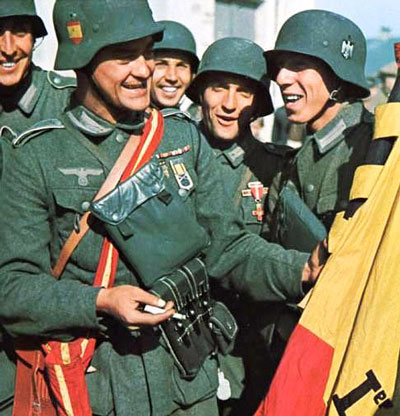 |
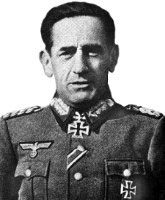 |
After a month of training the division entered the German army as the 250th Infantry Division and began its long march to the front, where it was to be assigned to Kluge’s 4th Army in Army Group Center. Problems with discipline continued, and the division was often paraded and marched pointlessly to get them used to the German way of doing things, which of course included not fraternizing with local women.
Forced to undergo such a parade in Grodno, an entire company marched with condoms stretched across their rifle muzzles. On the road to Minsk the Germans had enough. While still en route the division refused to yield right of way to some members of von Kluge’s staff. He refused the Spanish unit, after which they were forced to march north to join the 16th Army in Army Group North.
|
|
Attached to the 39th Corps, in October and November the unit participated in successful attacks on Soviet positions, impressing General Busch (CO 16th Army) who once observed them in combat. On January 13, 1942, the Soviets counterattacked and routed some units of the 39th, yet the Spanish held onto their hedgehog around Novgorod for over two months without retreating until the Soviet attacks ceased. The division held its defensive positions until August, when it was pulled out of line to re-equip and join von Manstein’s 11th Army for an assault on Leningrad.
During the see-saw battles over the next few months the Blue division gave a fine account of itself, often out performing German units stationed on its flank. In December, the division was dealt a blow as Grandes was recalled to Spain. Franco feared his popularity with the Germans and did not want risk Spain being dragged further into the conflict. His replacement, Esteban Infantes, was not liked by the Germans, but proved a capable leader, even if not up to Grandes ability.
The Soviets had finally relieved the siege of Leningrad at the end of January 1943. In an effort to expand its slender lifeline, amounting to a five mile corridor, the Soviets attacked on February 10, hitting the Spanish at a town known as Krasni Bor. This would be the Blue Division’s finest hour, and its death knell. Attacked by three Soviet divisions (43rd Rifle, 72nd rifle, and 63rd Guards), supported by nearly 400 artillery and 60 tanks, the Spanish were threatened with encirclement and destruction.
|
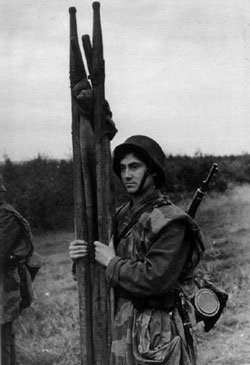 |
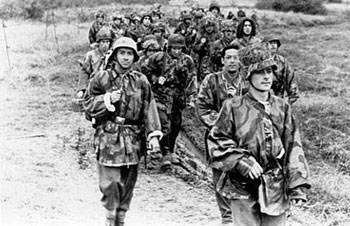 |
The battle raged all day and night, with requested German reinforcements not arriving until the waning hours after midnight. The battle was brutal, fought at close quarters, more reminiscent of the Great War than WWII. As dawn rose on the morning of the 11th, fighting continued sporadically as both sides were too battered to continue. Sources on Soviet losses vary, but place the number between 7,000 and 11,000. The Spanish casualties were less than 2,500. The Soviets had gained a devastated ghost town and a few kilometers of trenches.
For the balance of 1943 the mission of the unit became increasingly questioned in Madrid. The war was clearly turning against the Axis and Franco did not want to risk alienating the United States.
|
|
The division continued to fight and hold the line, but morale was starting to suffer, as most of the original line officers were dead and replacements were not up to par. On October 1st, Francisco Franco officially announced Spanish neutrality and the division prepared to withdraw.
Still wanting to appease Hitler, as the Blue Division was being repatriated, a “Spanish Legion” was being formed in Madrid. With an initial strength of 1,500, this unit was back in the line in December. Quality was poor, with some former Socialists and other left-wingers volunteering only to desert once in the Soviet Union. In May 1944, this rump unit was withdrawn under political pressure. Some diehard anti-Communists stayed on, joining the SS. They would be present during the final fighting for Berlin.
|
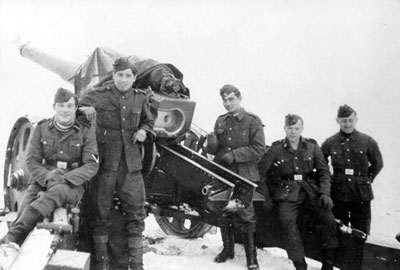 |
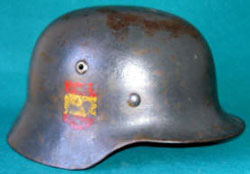 |
1941
Divisional General Staff (General Munoz Grandes) (189 men)
262 Infantry Regiment (Col. Miguel Rodrigo Martinez) (3012 men)
263 Infantry Regiment (Col. Pedro Pimentel Zayas) (3012 men)
269 Infantry Regiment (Col. José Vierna Trábega) (3012 men)
250 Anti-tank Battalion (574 men)
Motorised 3.7cm PaK 36 guns |
250 Artillery Regiment (Col. José Martínez Esparza) (2793 men)
9 Batteries of 10.5cm leFH 18 Howitzers, 3 Batteries of 15cm sFH 18 Howitzers)
250 Reconnaissance Battalion (531)
250 Reserve Battalion (601 men)
250 Signals Battalion (511 men)
250 Pioneer Battalion (712 men)
Divisional Troops
Transport service (1034 men)
Administrative services (257 men)
Medical service (518 men)
Veterinary service (237 men)
Military police (33 men)
Military post office (18 men) |
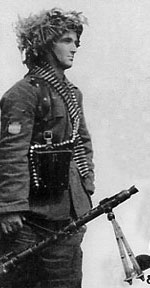 |
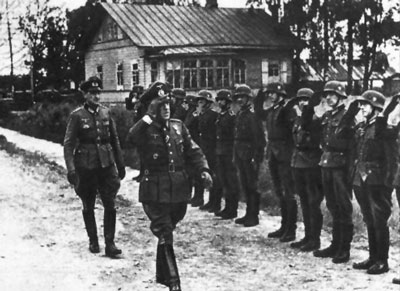 |
September 1943
Divisional General Staff (General Esteban Infantes)
262 Grenadier Regiment
263 Grenadier Regiment
269 Grenadier Regiment
250 Anti-tank Battalion
Motorised 7.5cm PaK 40, 5cm, PaK 38 and 3.7cm PaK 36 guns
250 Artillery Begiment
9 Batteries of 10.5cm leFH 18 Howitzers, 2 Batteries of 21cm French Howitzers, 1 Battery of 15.5cm French Howitzers
250 Reconnaissance Battalion
250 Signals Battalion
250 Pioneer Battalion
Divisional Troops
Supply, transport and administration. |
|
Using the Blue Division in Flames of War
The Spanish troops used German uniforms and equipment, thus the Blue division is adequately represented by Mid-war German Grenadier model range. The only visible difference being their yellow and red national shield worn on the helmet right and the right upper arm.
To Field them use the Grenadier Company from Iron Cross. The Spanish troops of Division Azul were all volunteers with a strong will to fight communism, as such they have the same strong ratings as the German Grenadiers. Though, if you would like to give them a bit more go forward you might like the use the Iron Cross Croatian Rifle Company command card to represent them, giving them Counterattack 3+.
Review of Osprey’s Blue Division Soldier 1941-45, Spanish Volunteers on the Eastern Front:
Blue Division Soldier 1941-45, Spanish Volunteers on the Eastern Front…. |
|









